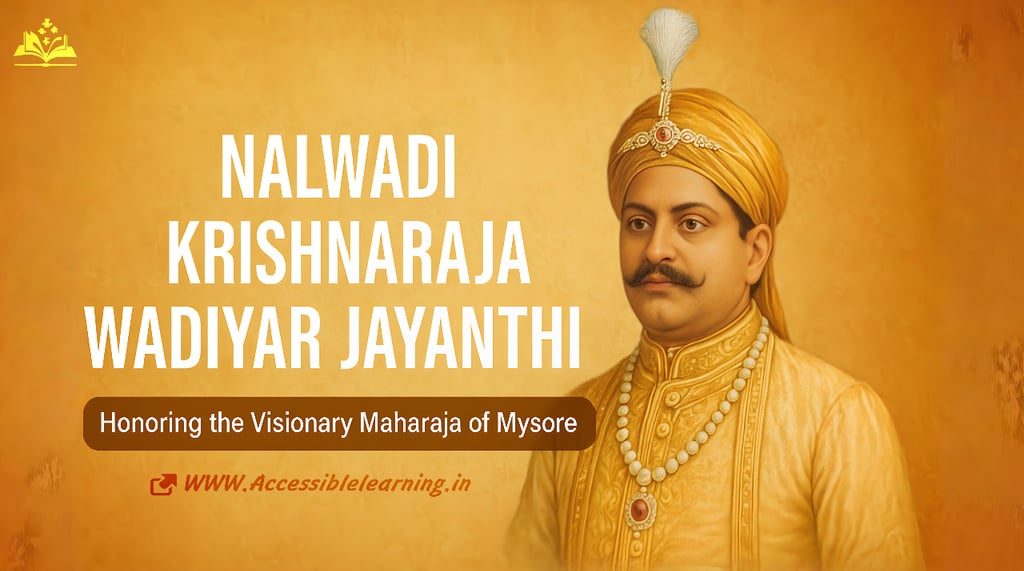
Nalwadi Krishnaraja Wadiyar Jayanthi: Remembering the Visionary Maharaja of Modern Mysore
Discover the legacy of Nalwadi Krishnaraja Wadiyar IV, the visionary Maharaja who transformed Mysore into a model state. Celebrate his Jayanthi on June 4 with insights into his progressive rule, social reforms, and cultural impact on modern India.
CULTURE/TRADITIONEVENT/SPECIALINDIA/BHARATCELEBRATION/FESTIVALS
Sachin K Chaurasiya
6/1/20253 min read


A Jayanthi That Celebrates a Golden Era
Every year on June 4, the people of Karnataka commemorate Nalwadi Krishnaraja Wadiyar Jayanthi, paying tribute to a king who ruled with his heart, intellect, and progressive ideals. More than a celebration, it’s a reflection of the values of good governance, social justice, and inclusive development.
Born into royalty but remembered as a servant of the people, Wadiyar IV turned the princely state of Mysore into an exemplary region in British India—an India that was still finding its path to modernity.
The Maharaja Who Ruled Like a Saint
Full Name: Sri Krishnaraja Wadiyar IV
Born: June 4, 1884
Reign: 1902 – 1940
Died: August 3, 1940
Nickname: Rajarshi (King-Saint)
Educated under British tutors and Indian scholars, Nalwadi Krishnaraja Wadiyar emerged as a rare fusion of tradition and modernity. At just 16, he was declared Maharaja after the death of his father. He officially took over administration in 1902, guided initially by his mother, Maharani Vani Vilas Sannidhana, and Dewan Sir Seshadri Iyer.
Progressive Reforms That Shaped a State
Education for All
Introduced free, compulsory primary education.
Reserved 50% of scholarships for SC/ST and backward communities, long before such policies became national mandates.
Founded the University of Mysore in 1916—one of the first outside of British India.
Pioneering Industrialization
Mysore Iron & Steel Works (Bhadravati) helped industrialize southern India.
Supported early aviation technology—a visionary step that laid foundations for HAL.
Encouraged local entrepreneurship and artisanship through cooperative societies.
India's First Hydroelectric Plant
Established at Shivanasamudra Falls in 1902, it powered the Kolar Gold Fields and made Bangalore Asia’s first city with electric streetlights.
Healthcare & Sanitation
Built modern hospitals, dispensaries, and public health labs.
Emphasized sanitation during outbreaks like plague and cholera, saving thousands of lives.
Launched maternity hospitals and mother-child care schemes.
A Royal Patron of Arts, Music, and Culture
Krishnaraja Wadiyar was also a renaissance king, nurturing art, architecture, and music.
Patron of Carnatic music, he supported legends like Veena Seshanna, Mysore Vasudevacharya, and Bidaram Krishnappa.
Initiated Dasara cultural celebrations, blending royal tradition with public participation.
Commissioned the Mysore Palace reconstruction after it was destroyed by fire—a symbol of Indo-Saracenic architectural brilliance.
Supported printing presses and Kannada literature, giving rise to cultural icons like Masti Venkatesha Iyengar and Kuvempu.

Lesser-Known but Fascinating Facts
Pacifist Monarch: During WWI, he contributed to the British war fund but simultaneously advocated peace and neutrality in internal affairs.
First Indian State to Hold a Representative Assembly (1907): Before Indian democracy even began, Mysore had an early form of people’s representation.
Gandhiji’s Admiration: Mahatma Gandhi called him "A Rajarshi," a rare honor, praising his integrity and the welfare-driven governance model.
Women's Empowerment Pioneer: He introduced exclusive scholarships for girls and allowed women to become teachers, writers, and administrators.
Environment-Friendly Urban Design: Mysore was built with tree-lined boulevards, gardens, and sustainable water systems—a city decades ahead of its time.
Spiritual and Scientific Thinker: Though deeply religious, he supported modern science, welcoming the establishment of research institutions like the Indian Institute of Science (IISc) in Bangalore.
Celebration of Nalwadi Krishnaraja Wadiyar Jayanthi
When is it observed?
Date: June 4 (Birth Anniversary)
Location: Predominantly Karnataka, but increasingly celebrated across India by historians, educators, and cultural organizations.
How is it celebrated?
State Functions: Speeches, awards, and floral tributes organized by the Karnataka government.
Educational Events: Competitions, cultural shows, and exhibitions in schools and colleges.
Public Participation: Processions, folk music events, and digital tributes from influencers and cultural groups.
Trending Hashtags: #RajarshiWadiyar #WadiyarJayanthi #KingOfHearts
Why His Legacy Matters Today
In today’s world, where leadership is often transactional, Krishnaraja Wadiyar’s story inspires a return to values-driven governance. His model wasn’t based on control but compassion; not on wealth, but wisdom.
His priorities—education, public health, sustainability, social inclusion, and cultural pride—are still the cornerstones of a progressive, balanced society.
Nalwadi Krishnaraja Wadiyar IV wasn’t just a ruler; he was a visionary institution in himself. His reign reminds us that power, when blended with compassion and vision, can transform lives for generations.
As we celebrate Nalwadi Krishnaraja Wadiyar Jayanthi, we aren’t just looking back—we’re drawing forward, from the rich well of history, to inspire a more just, humane, and enlightened future.
FAQs
Who was Nalwadi Krishnaraja Wadiyar IV?
Nalwadi Krishnaraja Wadiyar IV was the 24th Maharaja of the Kingdom of Mysore, widely revered as a progressive and visionary ruler. His reign from 1902 to 1940 saw Mysore become a model state known for education, infrastructure, and social welfare.
When is Krishnaraja Wadiyar Jayanthi celebrated?
Krishnaraja Wadiyar Jayanthi is celebrated annually on June 4th to commemorate the birth anniversary of the Maharaja, born in 1884.
Why is he called 'Rajarshi'?
He was called 'Rajarshi' by Mahatma Gandhi, meaning “a royal sage,” due to his deep spiritual values combined with ethical, humanitarian, and visionary leadership.
What are some major contributions of Krishnaraja Wadiyar IV?
Founding the University of Mysore (1916)
Developing electrification in Bangalore and Mysore
Promoting women’s education and temple entry reforms
Expanding irrigation, healthcare, and public transport
How is his Jayanthi celebrated in Karnataka?
On this day, cultural programs, tribute ceremonies, educational events, and statue garlandings are organized across Mysore, Bangalore, and other parts of Karnataka to honor his legacy.
What made Mysore a 'Model State' under his rule?
Under his rule, Mysore became a beacon of welfare governance, low poverty, high literacy, and early industrialization—earning national admiration and becoming a blueprint for post-independence India.
Subscribe To Our Newsletter
All © Copyright reserved by Accessible-Learning Hub
| Terms & Conditions
Knowledge is power. Learn with Us. 📚


